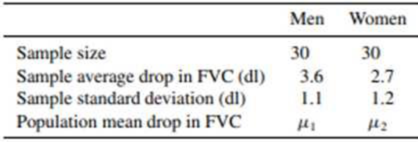
How would you like to live to be 200 years old? For centuries, humankind has sought the key to the mystery of aging. What causes aging? How can aging be slowed? Studies have focused on biomarkers, physical or biological changes that occur at a predictable time in a person’s life. The theory is that, if ways can be found to delay the occurrence of these biomarkers, human life can be extended. A key biomarker, according to scientists, is forced vital capacity (FVC), the volume of air that a person can expel after taking a deep breath. A study of 5209 men and women aged 30 to 62 showed that FVC declined, on the average, 3.8 deciliters (dl) per decade for men and 3.1 deciliters per decade for women.10 Suppose that you wished to determine whether a physical fitness program for men and women aged 50 to 60 would delay aging: to do so, you measured the FVC for 30 men and 30 women participating in the fitness program at the beginning and end of the 50-to 60-year age interval and recorded the drop in FVC for each person. A summary of the data appears in the accompanying table.

- a Do the data provide sufficient evidence to indicate that the decrease in the
mean FVC over the decade for the men on the physical fitness program is less than 3.8 dl? Find the attained significance level for the test. - b Refer to part (a). If you choose α = .05, do the data support the contention that the mean decrease in FVC is less titan 3.8 dl?
- c Test to determine whether the FVC drop for women on the physical fitness program was less than 3.1 dl for the decade. Find the attained significance level for the test.
- d Refer to part (c). If you choose α = .05, do the data support the contention that the mean decrease in FVC is less than 3.1 dl?
Want to see the full answer?
Check out a sample textbook solution
Chapter 10 Solutions
Mathematical Statistics with Applications
- Let X be a random variable with support SX = {−3, 0.5, 3, −2.5, 3.5}. Part ofits probability mass function (PMF) is given bypX(−3) = 0.15, pX(−2.5) = 0.3, pX(3) = 0.2, pX(3.5) = 0.15.(a) Find pX(0.5).(b) Find the cumulative distribution function (CDF), FX(x), of X.1(c) Sketch the graph of FX(x).arrow_forwardA well-known company predominantly makes flat pack furniture for students. Variability with the automated machinery means the wood components are cut with a standard deviation in length of 0.45 mm. After they are cut the components are measured. If their length is more than 1.2 mm from the required length, the components are rejected. a) Calculate the percentage of components that get rejected. b) In a manufacturing run of 1000 units, how many are expected to be rejected? c) The company wishes to install more accurate equipment in order to reduce the rejection rate by one-half, using the same ±1.2mm rejection criterion. Calculate the maximum acceptable standard deviation of the new process.arrow_forward5. Let X and Y be independent random variables and let the superscripts denote symmetrization (recall Sect. 3.6). Show that (X + Y) X+ys.arrow_forward
- 8. Suppose that the moments of the random variable X are constant, that is, suppose that EX" =c for all n ≥ 1, for some constant c. Find the distribution of X.arrow_forward9. The concentration function of a random variable X is defined as Qx(h) = sup P(x ≤ X ≤x+h), h>0. Show that, if X and Y are independent random variables, then Qx+y (h) min{Qx(h). Qr (h)).arrow_forward10. Prove that, if (t)=1+0(12) as asf->> O is a characteristic function, then p = 1.arrow_forward
- 9. The concentration function of a random variable X is defined as Qx(h) sup P(x ≤x≤x+h), h>0. (b) Is it true that Qx(ah) =aQx (h)?arrow_forward3. Let X1, X2,..., X, be independent, Exp(1)-distributed random variables, and set V₁₁ = max Xk and W₁ = X₁+x+x+ Isk≤narrow_forward7. Consider the function (t)=(1+|t|)e, ER. (a) Prove that is a characteristic function. (b) Prove that the corresponding distribution is absolutely continuous. (c) Prove, departing from itself, that the distribution has finite mean and variance. (d) Prove, without computation, that the mean equals 0. (e) Compute the density.arrow_forward
- 1. Show, by using characteristic, or moment generating functions, that if fx(x) = ½ex, -∞0 < x < ∞, then XY₁ - Y2, where Y₁ and Y2 are independent, exponentially distributed random variables.arrow_forward1. Show, by using characteristic, or moment generating functions, that if 1 fx(x): x) = ½exarrow_forward1990) 02-02 50% mesob berceus +7 What's the probability of getting more than 1 head on 10 flips of a fair coin?arrow_forward

 Glencoe Algebra 1, Student Edition, 9780079039897...AlgebraISBN:9780079039897Author:CarterPublisher:McGraw Hill
Glencoe Algebra 1, Student Edition, 9780079039897...AlgebraISBN:9780079039897Author:CarterPublisher:McGraw Hill

